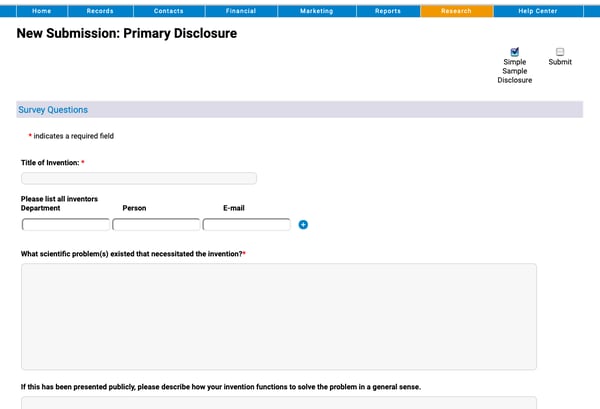Organized workflow management can make or break an office. As soon as a staff member logs into Sophia, they play a role in enabling your team to develop and grow a robust portfolio of technologies and IP. How can you support this process as a system administrator?
Step One: Disclosures

Your researcher has an idea and needs somewhere to put it. While Sophia includes a basic invention disclosure form for teams to use, you can also create fully-customized submission forms and workflows to further streamline your office’s operations. With the Online Submissions Module, Wellspring Clients have identified several best practices for maintaining a comprehensive yet straightforward disclosure process:
- Short and sweet: Forms of < 5 pages and ideally 3 pages increases the rate at which disclosures are completed.
- The Disclosure starts the conversation: Detailed technical or market information is often best done through an exploratory conversation.
- Minimal assistance needed: By creating online forms that include only the most crucial, simple prompts and limited textboxes, you ensure that your researchers are not bogged down by pages of prompts. This makes it as easy as possible for them to submit accurate, complete records for you to review.
- Enable sign-off: Confirming agreement, especially for inventorship, is best done using automated consent from each inventor at the time of disclosure. As time passes, agreement among the inventor team can be increasingly difficult.
Step Two: Advanced Workflows
 After receiving and approving your researchers’ submissions in Sophia, you are ready to evaluate your technologies. Similar to the disclosure forms, Sophia provides teams with standard workflow templates that offices can use to manage basic invention processes. Here, teams must prioritize four principles: Organization, Efficiency, Accuracy, and Communication.
After receiving and approving your researchers’ submissions in Sophia, you are ready to evaluate your technologies. Similar to the disclosure forms, Sophia provides teams with standard workflow templates that offices can use to manage basic invention processes. Here, teams must prioritize four principles: Organization, Efficiency, Accuracy, and Communication.
While Sophia’s standard workflows enable fundamental evaluation steps, offices can also use the Advanced Workflows Module to go a step further and assign tasks to specific team members. In doing so, teams collectively see detailed technology roadmaps and eliminate ambiguity regarding who owns which process steps. Understanding task ownership also reduces the risk of accidental duplication of work or delays in evaluations moving from one step to the next. Lastly, setting up auto-alerts and reminders for upcoming workflow tasks adds another layer of accountability to maintaining well-oiled processes throughout the team.
Questions on how to add custom forms and workflows to your Sophia system? For more information, please contact solutions@wellspring.com.
Image by Mudassar Iqbal from Pixabay




